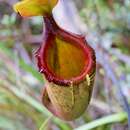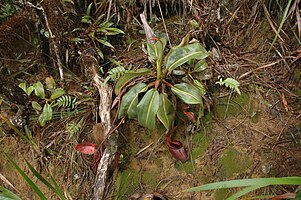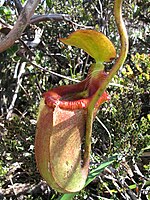en
names in breadcrumbs


Nepenthes × kinabaluensis /nɪˈpɛnθiːz ˌkɪnəbɑːluˈɛnsɪs/, or the Kinabalu pitcher-plant,[3] is the natural hybrid between N. rajah and N. villosa.[4] It was first collected near Kambarangoh on Mount Kinabalu, Borneo by Lilian Gibbs in 1910 and later mentioned by John Muirhead Macfarlane as "Nepenthes sp." in 1914.[5] Although Macfarlane did not formally name the plant, he noted that "[a]ll available morphological details suggest that this is a hybrid between N. villosa and N. rajah".[6] It was finally described in 1976 by Shigeo Kurata as N. × kinabaluensis. The name was first published in Nepenthes of Mount Kinabalu, but was a nomen nudum at the time as it lacked an adequate description and information on the type specimen. The name was subsequently published validly by Kurata in 1984.[7]
The pitchers of N. × kinabaluensis may be quite large, but do not compare to those of N. rajah or N. × alisaputrana (N. burbidgeae × N. rajah). Nepenthes × kinabaluensis can only be found on Mount Kinabalu (hence the name) and nearby Mount Tambuyukon, where the two parent species occur sympatrically.[8] More specifically, plants are known from a footpath near Paka Cave and several places along an unestablished route on a south-east ridge, which lies on the west side of the Upper Kolopis River.[5] The only accessible location from which this hybrid is known is the Kinabalu summit trail, between Layang-Layang and the helipad, where it grows at about 2900 m in a clearing dominated by Dacrydium gibbsiae and Leptospermum recurvum trees. Nepenthes × kinabaluensis has an altitudinal distribution of 2420 to 3030 m.[9] It grows in open areas in cloud forest.
The hybrid is generally intermediate in appearance between its parent species. Raised ribs line the inner edge of the peristome and end with elongated teeth. These are more prominent than those found in N. rajah and smaller than those of N. villosa. The peristome is coarse and expanded at the margin (but not scalloped like that of N. rajah), the lid orbiculate or reniform and almost flat. In general, pitchers are larger than those of N. villosa and the tendril joins the apex about 1–2 cm below the leaf tip, a feature which is characteristic of N. rajah.[10] In older plants, the tendril can be almost woody. N. × kinabaluensis is an indumentum of villous hairs covering the pitchers and leaf margins, which is approximately intermediate between the parents. Lower pitchers have two fringed wings, whereas the upper pitchers usually lack these. The colour of the pitcher varies from yellow to scarlet. N. × kinabaluensis seems to produce upper pitchers more readily than either of its parents. In all respects N. × kinabaluensis is intermediate between the two parent species and it is easy to distinguish from all other Nepenthes of Borneo. However, it has been confused once before, when the hybrid was identified as N. rajah in Letts Guide to Carnivorous Plants of the World.[11]
Nepenthes × kinabaluensis /nɪˈpɛnθiːz ˌkɪnəbɑːluˈɛnsɪs/, or the Kinabalu pitcher-plant, is the natural hybrid between N. rajah and N. villosa. It was first collected near Kambarangoh on Mount Kinabalu, Borneo by Lilian Gibbs in 1910 and later mentioned by John Muirhead Macfarlane as "Nepenthes sp." in 1914. Although Macfarlane did not formally name the plant, he noted that "[a]ll available morphological details suggest that this is a hybrid between N. villosa and N. rajah". It was finally described in 1976 by Shigeo Kurata as N. × kinabaluensis. The name was first published in Nepenthes of Mount Kinabalu, but was a nomen nudum at the time as it lacked an adequate description and information on the type specimen. The name was subsequently published validly by Kurata in 1984.

 Left: A rosette plant with lower pitchers from Mount Kinabalu
Left: A rosette plant with lower pitchers from Mount KinabaluThe pitchers of N. × kinabaluensis may be quite large, but do not compare to those of N. rajah or N. × alisaputrana (N. burbidgeae × N. rajah). Nepenthes × kinabaluensis can only be found on Mount Kinabalu (hence the name) and nearby Mount Tambuyukon, where the two parent species occur sympatrically. More specifically, plants are known from a footpath near Paka Cave and several places along an unestablished route on a south-east ridge, which lies on the west side of the Upper Kolopis River. The only accessible location from which this hybrid is known is the Kinabalu summit trail, between Layang-Layang and the helipad, where it grows at about 2900 m in a clearing dominated by Dacrydium gibbsiae and Leptospermum recurvum trees. Nepenthes × kinabaluensis has an altitudinal distribution of 2420 to 3030 m. It grows in open areas in cloud forest.
The hybrid is generally intermediate in appearance between its parent species. Raised ribs line the inner edge of the peristome and end with elongated teeth. These are more prominent than those found in N. rajah and smaller than those of N. villosa. The peristome is coarse and expanded at the margin (but not scalloped like that of N. rajah), the lid orbiculate or reniform and almost flat. In general, pitchers are larger than those of N. villosa and the tendril joins the apex about 1–2 cm below the leaf tip, a feature which is characteristic of N. rajah. In older plants, the tendril can be almost woody. N. × kinabaluensis is an indumentum of villous hairs covering the pitchers and leaf margins, which is approximately intermediate between the parents. Lower pitchers have two fringed wings, whereas the upper pitchers usually lack these. The colour of the pitcher varies from yellow to scarlet. N. × kinabaluensis seems to produce upper pitchers more readily than either of its parents. In all respects N. × kinabaluensis is intermediate between the two parent species and it is easy to distinguish from all other Nepenthes of Borneo. However, it has been confused once before, when the hybrid was identified as N. rajah in Letts Guide to Carnivorous Plants of the World.
基纳巴卢山猪笼草(学名:Nepenthes × kinabaluensis)是由马来王猪笼草(N. rajah)和长毛猪笼草(N. villosa)杂交得到的自然杂交种。[2]
1910年,莉莲·苏泽特·吉布斯在堪巴兰格附近首次采集到了基纳巴卢山猪笼草。1914年,约翰·缪尔黑德·麦克法兰将其称为“Nepenthes sp.”。[3]:64虽然约翰·缪尔黑德·麦克法兰没有对其进行正式命名,但他指出“所有现有的形态细节表明其为长毛猪笼草与马来王猪笼草的杂交种”。[4]:1271976年,仓田重夫将其正式描述为基纳巴卢山猪笼草。该名称首次发表于《基纳巴卢山的猪笼草》一书中,但当时因其缺乏模式标本的信息及足够的描述,而被视为裸名。1984年,仓田重夫对其进行了有效描述。[5]
基纳巴卢山猪笼草的捕虫笼很巨大,但不如马来王猪笼草和阿里猪笼草(N. × alisaputrana)。基纳巴卢山猪笼草仅存在于基纳巴卢山及附近的坦布幼昆山,并与亲本同域分布。[6]:165-167更具体来说,其存在于帕卡洞附近的步道及卡鲁比斯河上游西岸的一个山脊的东南部。[3]:65。唯一容易到达的分布地位于基纳巴卢山顶峰步道,拉央-拉央与直升机停机坪之间,由陆均松属(Dacrydium gibbsiae)及薄子木属(Leptospermum recurvum)植物组成的树林,海拔约2900米。基纳巴卢山猪笼草的海拔分布范围为2420米至3030米。[7]:94原生地通常为云雾森林。
基纳巴卢山猪笼草为其亲本的中间型。其与马来王猪笼草之间的区别在于,其存在突出的唇肋及细长的唇齿。唇边缘扩展,笼盖为圆形或肾形,几乎水平。一般情况下,其捕虫笼大于长毛猪笼草。笼蔓与叶片的衔接处距离叶尖1至2厘米,该特征继承于马来王猪笼草。[8]:19成年植株的笼蔓几乎是木质的。其捕虫笼和叶片边缘具绒毛,呈亲本的中间型。下位笼具一对笼翼,而上位笼通常缺失。捕虫笼为黄色至血红色。其比亲本更容易产生上位笼。
基纳巴卢山猪笼草呈其亲本的中间型,可很容易的与婆罗洲的其他猪笼草属植物区分开来。但其曾在《莱茨领你到食虫植物世界》(Letts Guide to Carnivorous Plants of the World)中被误认为是马来王猪笼草。[9]
寬葉豬籠草
源小猪笼草
拟翼状猪笼草
翼状猪笼草
白猪笼草
白环猪笼草
阿札潘山猪笼草
苹果猪笼草
安达曼猪笼草
昂嘎桑猪笼草
附盖猪笼草
阿金特猪笼草
马兜铃猪笼草
阿滕伯勒猪笼草
贝卡利猪笼草
贝里猪笼草
本斯通猪笼草
二齿猪笼草
波哥猪笼草
邦苏猪笼草
博世猪笼草
豹斑猪笼草
伯克猪笼草
风铃猪笼草
塞西尔猪笼草
象岛猪笼草
陈氏猪笼草
熙德猪笼草
圆盾猪笼草
柯普兰猪笼草
丹瑟猪笼草
N. adnata
N. abgracilis
N. abalata
N. alata
N. alba
N. albomarginata
N. alzapan
N. ampullaria
N. andamana
N. angasanensis
N. appendiculata
N. argentii
N. aristolochioides
N. attenboroughii
N. beccariana
N. bellii
N. benstonei
N. bicalcarata
N. bokorensis
N. bongso
N. boschiana
N. burbidgeae
N. burkei
N. campanulata
N. ceciliae
N. chang
N. chaniana
N. cid
N. clipeata
N. copelandii
N. danseri
迪安猪笼草
密花猪笼草
上位猪笼草
滴液猪笼草
疑惑猪笼草
爱德华猪笼草
鞍型猪笼草
附生猪笼草
真穗猪笼草
绝灭猪笼草
艾玛猪笼草
法萨猪笼草
杏黄猪笼草
暗色猪笼草
甘通山猪笼草
无毛猪笼草
有腺猪笼草
小花猪笼草
小猪笼草
瘦小猪笼草
裸瓶猪笼草
钩唇猪笼草
汉密吉伊坦山猪笼草
赫姆斯利猪笼草
刚毛猪笼草
粗毛猪笼草
霍尔登猪笼草
胡瑞尔猪笼草
无刺猪笼草
卓越猪笼草
泉氏猪笼草
N. deaniana
N. densiflora
N. diatas
N. distillatoria
N. dubia
N. edwardsiana
N. ephippiata
N. epiphytica
N. eustachya
N. extincta
N. eymae
N. faizaliana
N. flava
N. fusca
N. gantungensis
N. glabrata
N. glandulifera
N. graciliflora
N. gracilis
N. gracillima
N. gymnamphora
N. hamata
N. hamiguitanensis
N. hemsleyana
N. hirsuta
N. hispida
N. holdeni
N. hurrelliana
N. inermis
N. insignis
N. izumiae
贾桂琳猪笼草
马桶猪笼草
容洪猪笼草
贡布猪笼草
克尔猪笼草
印度猪笼草
奇坦兰山猪笼草
克罗斯猪笼草
空堪达猪笼草
仓田猪笼草
蓝姆猪笼草
熔岩猪笼草
莱昂纳多猪笼草
莱特岛猪笼草
小舌猪笼草
长叶猪笼草
劳氏猪笼草
麦克法兰猪笼草
大叶猪笼草
大型平庸猪笼草
马达加斯加猪笼草
曼塔灵阿汉山猪笼草
马普鲁山猪笼草
马索亚拉半岛猪笼草
大猪笼草
美林猪笼草
小瓮猪笼草
迈克猪笼草
棉兰老岛猪笼草
惊奇猪笼草
奇异猪笼草
N. jacquelineae
N. jamban
N. junghuhnii
N. kampotiana
N. kerrii
N. khasiana
N. kitanglad
N. klossii
N. kongkandana
N. kurata
N. lamii
N. lavicola
N. leonardoi
N. leyte
N. lingulata
N. longifolia
N. lowii
N. macfarlanei
N. macrophylla
N. macrovulgaris
N. madagascariensis
N. mantalingajanensis
N. mapuluensis
N. masoalensis
N. maxima
N. merrilliana
N. micramphora
N. mikei
N. mindanaoensis
N. mira
N. mirabilis
柔毛猪笼草
山地猪笼草
姆鲁山猪笼草
毛律山猪笼草
龙猪笼草
内格罗斯岛猪笼草
新几内亚猪笼草
黑猪笼草
诺斯猪笼草
卵形猪笼草
巴拉望岛猪笼草
圆锥猪笼草
巴布亚猪笼草
盾葉毛豬籠草
伯威尔猪笼草
有柄猪笼草
菲律宾猪笼草
细毛猪笼草
皮托庞猪笼草
宽唇猪笼草
美丽猪笼草
莱佛士猪笼草
馬來王豬籠草
岔刺猪笼草
拉莫斯猪笼草
两眼猪笼草
菱茎猪笼草
硬叶猪笼草
罗伯坎特利猪笼草
罗恩猪笼草
N. mollis
N. monticola
N. muluensis
N. murudensis
N. naga
N. negros
N. neoguineensis
N. nigra
N. northiana
N. ovata
N. palawanensis
N. paniculata
N. papuana
N. peltata
N. pervillei
N. petiolata
N. philippinensis
N. pilosa
N. pitopangii
N. platychila
N. pulchra
N. rafflesiana
N. rajah
N. ramispina
N. ramos
N. reinwardtiana
N. rhombicaulis
N. rigidifolia
N. robcantleyi
N. rowanae
萨马岛猪笼草
血红猪笼草
萨兰加尼猪笼草
辛布亚岛猪笼草
欣佳浪山猪笼草
斯迈尔斯猪笼草
匙叶猪笼草
显目猪笼草
窄叶猪笼草
苏门答腊猪笼草
素叻猪笼草
苏里高猪笼草
塔蓝山猪笼草
坚韧猪笼草
毛盖猪笼草
细猪笼草
泰国猪笼草
高棉猪笼草
多巴猪笼草
托莫里猪笼草
特勒布猪笼草
宝特瓶猪笼草
波叶猪笼草
超基猪笼草
维奇猪笼草
葫芦猪笼草
维耶亚猪笼草
长毛猪笼草
绿猪笼草
佛氏猪笼草
N. samar
N. sanguinea
N. saranganiensis
N. sibuyanensis
N. singalana
N. smilesii
N. spathulata
N. spectabilis
N. stenophylla
N. sumatrana
N. suratensis
N. surigaoensis
N. talangensis
N. tenax
N. tentaculata
N. tenuis
N. thai
N. thorelii
N. tobaica
N. tomoriana
N. treubiana
N. truncata
N. undulatifolia
N. ultra
N. veitchii
N. ventricosa
N. vieillardii
N. villosa
N. viridis
N. vogelii
阿里猪笼草
石龙门猪笼草
坎特利猪笼草
雪线猪笼草
红脉猪笼草
N. × alisaputrana
N. × bauensis
N. × cantleyi
N. × cincta
N. × ferrugineomarginata
哈里猪笼草
虎克猪笼草
基纳巴卢山猪笼草
古晋猪笼草
美翼猪笼草
N. × harryana
N. × hookeriana
N. × kinabaluensis
N. × kuchingensis
N. × merrilliata
妙翼猪笼草
潘丘卢保山猪笼草
梨形猪笼草
沙捞越猪笼草
沙礼花-哈萨猪笼草
N. × mirabilata
N. × pangulubauensis
N. × pyriformis
N. × sarawakiensis
N. × sharifah-hapsahii
毛果猪笼草
宝翼猪笼草
特鲁斯马迪山猪笼草
曾氏猪笼草
红瓶猪笼草
N. × trichocarpa
N. × truncalata
N. × trusmadiensis
N. × tsangoya
N. × ventrata